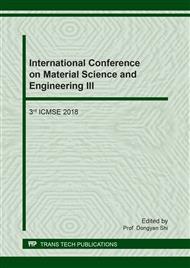p.103
p.109
p.115
p.120
p.126
p.132
p.137
p.144
p.148
Potential of Modified Corn Cob (Zea mays L.) and Petai Hull (Parkia hassk) as New Biosorbent for Removal of Lead Waste
Abstract:
Lead metal is one type of heavy metal that has high toxicity levels in the aquatic waste environment. The adsorption method is one of the alternatives in reducing heavy metal waste, by utilizing biosorbent. The purpose of this research is to study the process of making new biosorbent and to know the absorption of new biosorbent from corn cob (Zea mays L.) and petai hull (Parkia hassk) to dissolve lead metal waste (Pb). There are two types of biosorbents are ordinary (simplicia) biosorbents and modified biosorbents with nitric acid (HNO3). Synthetic waste is used in the form of Pb (II) metal ions from the Pb (NO3)2 solution using initial concentrations of 100, 200, 300, 400, and 500 mg / L. Biosorbents tested the concentration of metal ions with AAS and characterized using FTIR to determine functional groups. Maximum adsorption capacity was obtained by biosorbents D (simplicia) and H (HNO3) with Pb (II) adsorbed metal ion capacity of respectively 1.4175 mg/g and 2.230 mg/g at a concentration of 400 mg / l. The isotherm adsorption showed that the adsorption mechanism of Pb(II) ion fit for this study is seen from the values of R2 on C biosorbents is better with other adsorbents and respectively are followed Langmuir, Dubinin Radushkevich, Freundlich, and Langmuir isotherm adsorption.
Info:
Periodical:
Pages:
126-131
Citation:
Online since:
October 2018
Keywords:
Price:
Сopyright:
© 2018 Trans Tech Publications Ltd. All Rights Reserved
Share:
Citation:


